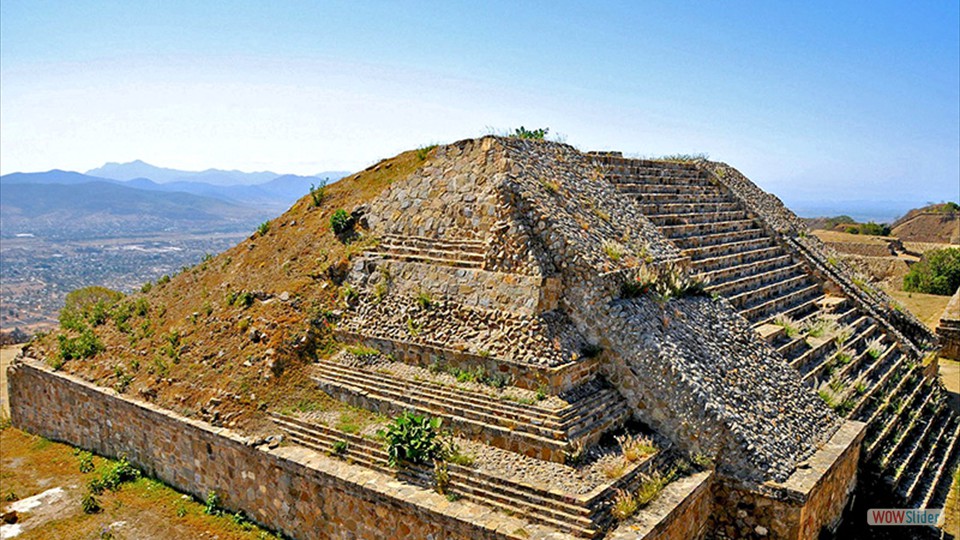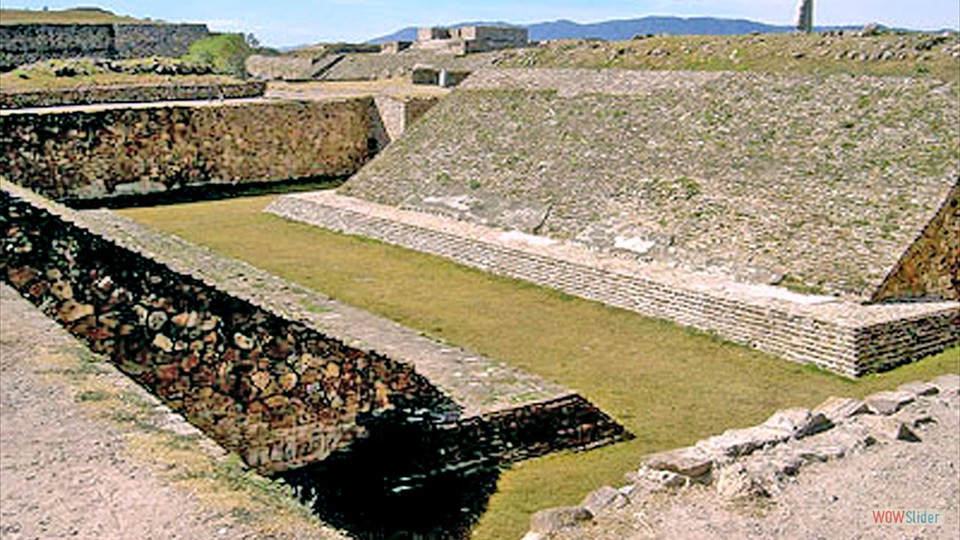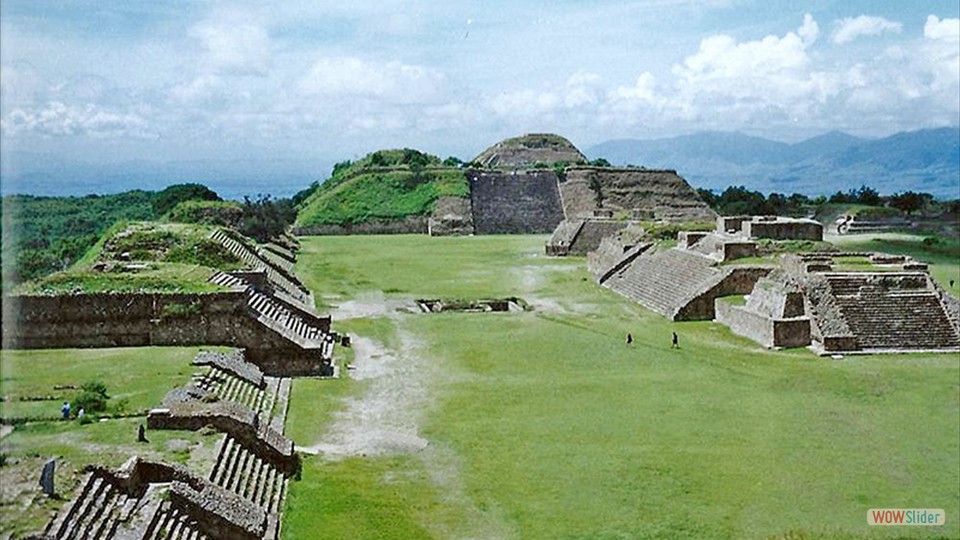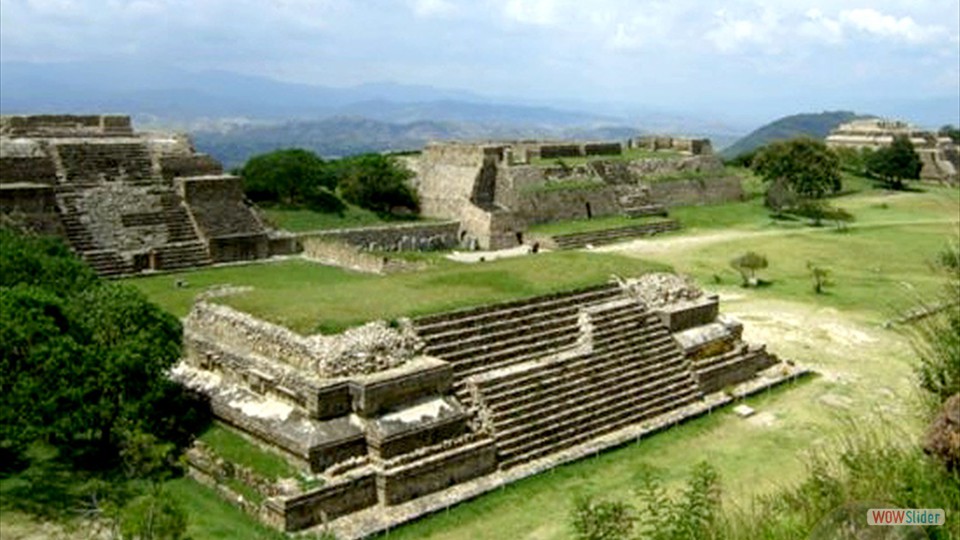Monte Alban was the ancient capital of the Zapotecs and one of the first cities in Mesoamerica. During it's epoch, it was one of the most populated. It was founded approximately 500 B.C.E. and flourished until 750 C.E.. Located in the central valley of Oaxaca, Monte Alban exercised political, economic, and ideological control over the other communities and surrounding mountains. Its principal constructions include the Great Plaza, the Ball Court, System II, The Danzantes (Dancers), Building J, Central Building G.H., the Palace, the southern platform, System 7 Deer and Tomb Number 7 of the Great Plaza.
The Ball Court is located to the left of the entrance to the Great Plaza, and has the defining characteristics of ball courts in this region. This court is marked by two structures at the sides of the rectangular base, with slanting walls. A sculpture representing a grasshopper covers most of the western side. The platform located on the western side contains a stair case flanked by two cross beams that end in slope, with two stelae in the largest part; there are two small niches contained there.
System II is a structure consisting of two bodies with a staircase, flanked by two cross beams, ending in slope with two panels of double scapular. In the largest area a small temple with a rectangular base and five columns in front and still others at the back without later walls. To the south of this area is a tunnel constructed with a vaulted roof that connects to the central building.
Building "J" is separated from the other building, and is without doubt one of the most interesting, owing to its orientation and form. Resembling an arrow point, it has two bodies. Its staircase is oriented toward the northwest, its vertical walls are covered with inscribed stones, and they believe that its inside chamber functioned for astronomical observations but this hasn't been proved. The Central Buildings G, H and I are located in the central part of the Great Plaza. The central building "H" is larger than the other two with a large staircase and two tombs. In the larger part we find a temple with two chambers and two columns at the entrance, very close to the lateral walls. In front of the principal staircase is a small templete with a quadrangular base, where we find the famous mask of the Bat God, covered in jade. The Palace is a two-part structure with a central staircase, with cross beams ending in the form of slope. In the upper part are 13 rooms grouped around a central patio. The doorway of this grouping is a lintel, recently arranged.
The Southern Platform is a very large structure that closed the plaza on this side. Of the two parts, in the larger part are two mounds, and from this spot one can observe all of the great ceremonial plaza. In the smaller part of this and in the corners various stelae are built-in with zoomorphic reliefs, as if some type of offering. System 7 Deer: To reach this location we recommend walking over the largest part of the southern platform, toward the southern platform in a southeastern direction. It is located approximately 250 meters from the main plaza. There are four structures surrounding a plaza oriented toward the four cardinal points. Tomb Number 7: On the 6 of January 1932, the Mexican archaeologist Dr. Alfonso Caso encountered a grave with a rich quantity of offerings. This is considered a great archaeological treasure, displayed in the Regional Museum of Oaxaca. This tomb is arranged on a rectangular base containing in front a bedroom and vaulted chamber. It is one of few tombs to have been found, and even though the building had deteriorated a bit, the treasures were intact.
The archeological zone Monte Alban is located 10 km. west of the state capital, Oaxaca City. The pre-hispanic name of Monte Alban has not been identified with precision. The most closely related descendants of the Zapotecs mention a hill that was known as Dhauya quch o Dauyacach, or the "Hill of the Sacred Stones". On the other hand, the Mixtecs know it as Yucucui, or "Green Hill". At the beginning of the 17th century, this spot came to be known as Monte Alban, owing to the fact that at that time, the lands belonged to a Spainard with the surname of Monte Alban or Montalban.








 1
1 2
2 3
3 4
4 5
5 6
6 7
7